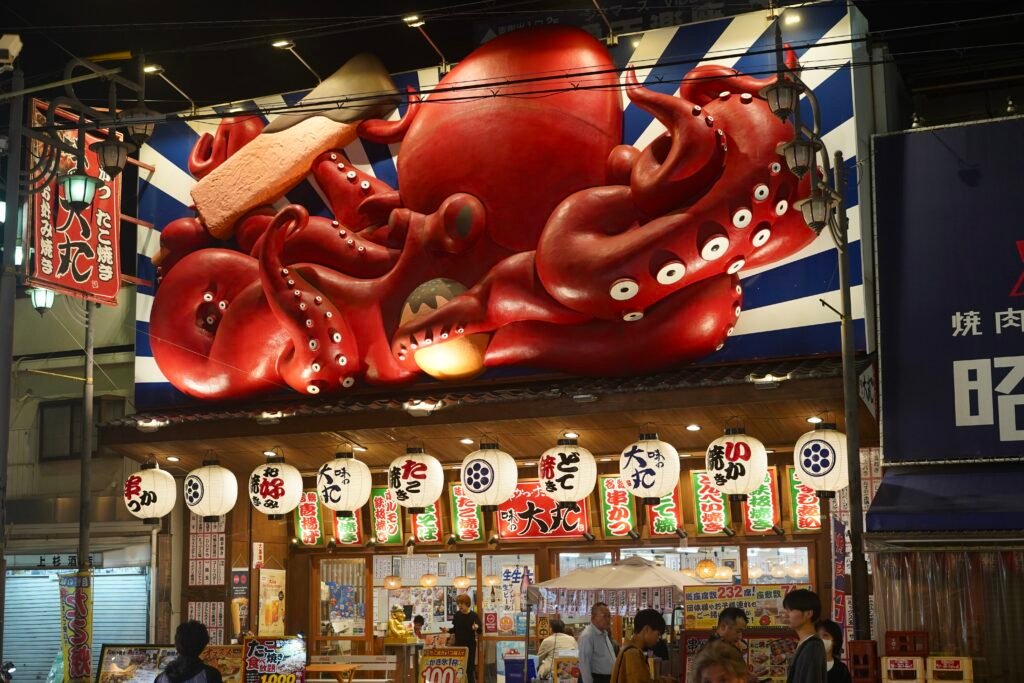Japan is renowned for its rich and diverse food culture, and its street food is no exception. From the sizzling aromas of Takoyaki to the savory flavors of Okonomiyaki, Japanese street food is a delicious adventure for any food lover. In this blog, we dive into the origins and unique characteristics of five iconic Japanese dishes: Takoyaki, Fugu, Okonomiyaki, Kushikatsu, and Yakiniku.
Takoyaki: Osaka’s Iconic Snack
Takoyaki is a popular street food dish that originated in Osaka, Japan. These round, doughy balls are filled with diced octopus, tempura scraps, and pickled ginger, then grilled to perfection in special Takoyaki pans. Typically topped with mayonnaise, takoyaki sauce, and bonito flakes, this dish is a true flavor bomb.
Takoyaki first gained popularity in the 1930s, thanks to street vendors who crafted this dish as a cheap, tasty snack for busy workers. Today, you can find Takoyaki in every corner of Japan, but it remains deeply tied to its Osaka roots.
Fugu: Japan’s Risky Delicacy
Fugu, or pufferfish, is one of Japan’s most famous and dangerous delicacies. Known for its potential toxicity if not prepared correctly, Fugu requires specially trained and licensed chefs to prepare. It has been a part of Japanese cuisine for centuries and is often served raw as sashimi, offering a mild, subtle flavor that fish enthusiasts seek out.
Although fugu is most commonly associated with more luxurious dining, it can also be found in certain specialty street markets. Its origin in Japanese cuisine dates back to ancient times, but modern-day fugu dining became widely known after regulations were put in place to ensure safety.
Okonomiyaki: Japan’s Savory Pancake
Okonomiyaki is a savory pancake-like dish that originates from the Kansai region, specifically Osaka and Hiroshima. The name translates to “grill what you like,” which perfectly describes the customizability of this dish. The batter is typically made from flour, eggs, and cabbage, and you can add various ingredients like pork, seafood, and vegetables.
Okonomiyaki is often topped with a combination of mayonnaise, okonomiyaki sauce, seaweed flakes, and bonito flakes. Both Kansai-style and Hiroshima-style Okonomiyaki have their own distinct methods of preparation, making this dish a must-try for anyone exploring Japan’s culinary diversity.
Kushikatsu: Fried Perfection on a Stick
Kushikatsu is another Osaka specialty that consists of skewered meats and vegetables coated in a light breadcrumb batter and deep-fried to crispy perfection. This street food has been around since the early 20th century, typically served with a side of dipping sauce and cabbage leaves to cleanse the palate between bites.
Kushikatsu offers a wide variety of options, from chicken and beef to lotus root and shrimp, making it a versatile dish enjoyed by both locals and tourists alike.
Yakiniku: Japanese BBQ
Yakiniku, or Japanese BBQ, is a beloved dining experience in Japan where diners grill their own meats at the table. The word “yakiniku” means “grilled meat,” and it typically features a variety of beef cuts, though pork and chicken are also popular choices. The concept of Yakiniku was introduced in the early 20th century, heavily influenced by Korean BBQ.
Yakiniku restaurants are popular across Japan, and some street food stalls also offer small-scale yakiniku options for a more casual, on-the-go meal. Diners often enjoy their grilled meats with dipping sauces such as soy-based tare.

